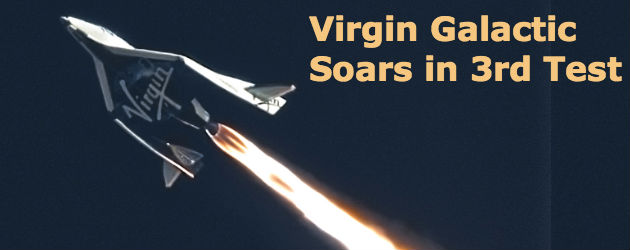Virgin Galactic Reaches New Heights in Third Supersonic Flight
 Talk about a high flying fleet, Virgin Galactic, the world’s first commercial spaceline, which is owned by Sir Richard Branson’s Virgin Group and Abu Dhabi’s aabar Investments PJS, successfully completed the third rocket-powered supersonic flight of its passenger carrying reusable space vehicle, SpaceShipTwo (SS2).
Talk about a high flying fleet, Virgin Galactic, the world’s first commercial spaceline, which is owned by Sir Richard Branson’s Virgin Group and Abu Dhabi’s aabar Investments PJS, successfully completed the third rocket-powered supersonic flight of its passenger carrying reusable space vehicle, SpaceShipTwo (SS2).
In command on the flight deck of SS2 for the first time under rocket power was Virgin Galactic’s Chief Pilot Dave Mackay, who was joined by Scaled Composites’ (Scaled) Test Pilot, Mark Stucky. The team tested the spaceship’s Reaction Control System (RCS) and the newly installed thermal protection coating on the vehicle’s tail booms. All of the test objectives were successfully completed.
The flight on Friday departed Mojave Air and Space Port at 7:22 a.m. PST with the first stage consisting of the WhiteKnightTwo (WK2) carrier aircraft lifting SS2 to an altitude around 46,000 ft. On release, SS2’s rocket motor was ignited, powering the spaceship to a planned altitude of 71,000 ft. – SS2’s highest altitude to date – and a maximum speed of Mach 1.4. SS2’s unique feather re-entry system was also tested during today’s flight.
Two important SS2 systems, the RCS and thermal protection coating, were tested during the flight in preparation for upcoming full space flights. The spaceship’s RCS will allow its pilots to maneuver the vehicle in space, permitting an optimal viewing experience for those on board and aiding the positioning process for spacecraft re-entry. The new reflective protection coating on SS2’s inner tail boom surfaces is being evaluated to help maintain vehicle skin temperatures while the rocket motor is firing.
SS2’s propulsion system has been developed by Sierra Nevada Corp and is the world’s largest operational hybrid rocket motor. Although this flight saw it burn for a planned 20 seconds, the system has been successfully tested in ground firings to demonstrate performance characteristics and burn time sufficient to take the spaceship and its private astronauts to space.
This flight was the third opportunity to see a supersonic, rocket-powered test of the Virgin Galactic system after dozens of successful subsonic test flights. “Today’s flight was another resounding success,” said Virgin Galactic CEO George Whitesides. “We focused on gathering more transonic and supersonic data, and our chief pilot, Dave, handled the vehicle beautifully. With each flight test, we are progressively closer to our target of starting commercial service in 2014.”
More info at: http://www.virgingalactic.com and
Category: Featured, General Update









